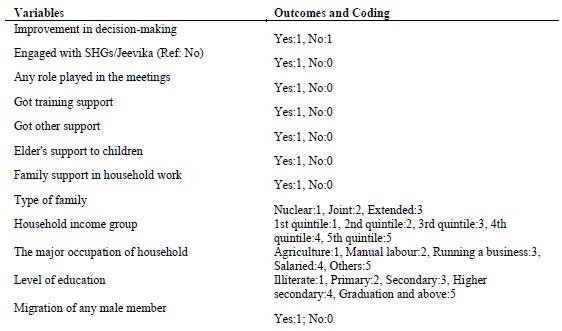The Role of JEEVIKA in Economic Empowerment of Women: A Case Study of Madhubani District of Bihar
DOI:
https://doi.org/10.54741/ssjar.3.6.2Keywords:
economic empowerment, shgs, jeevika, rural employment, women, migrationAbstract
The Self-help groups (SHGs) were formed to increase the financial inclusion of women and provide them with financial and technical support to find them good economic opportunities for their livelihood. Such a novel initiative garnered benefits for millions of women across rural and semi-urban regions and helped them to be economically empowered. In this paper, the role of Jeevika is analysed in the economic empowerment of women by taking the case study of the Madhubani district of Bihar. The study is based on primary data where the data is collected through a survey method through a closed-ended questionnaire. The sample size of the study is taken as 251 households. A logistic regression model is used to test the association between women’s economic empowerment and their engagement with SHGs/Jeevika. The result shows that there is a significant positive association between women’s economic empowerment and their engagement with Jeevika. A lower income, higher education, and family support in household work are also significantly associated with women’s economic empowerment.
Downloads
References
Batliwala, S. (1993). Empowerment of women in South Asia concept and practices. FAO. New Delhi.
Hoffmann V., Rao, V., Datta, U., Sanyal, P., Surendra, V., & Majumdar, S. (2018). Poverty and empowerment impacts of the Bihar rural livelihoods project in India. Impact Evaluation Report, 71.
Annual Report (2022). Jeevika. Rural Development Department Government of Bihar.
Jha, H. (2009). Need for an ideological struggle: Society and law in Bihar. in P. Chowdhry (Ed.), Gender discrimination in landownership and land reforms in India, 11, pp. 19–40. New Delhi, India: SAGE Publications.
Kabeer, N. (1999) Resources, agency, achievements: Reflections on the measurement of women’s empowerment. Development and Change, 30(3), 35–64. Available at: https://doi.org/10.1111/1467-7660.00125.
Kumar, R., Rajagopalan, R., & Agarwal, A. (2020). Women’s economic empowerment in India policy landscape action. The Quantum Hub.
Sen, Amartya. (2005). Human rights and capabilities. Journal of Human Development, 6(2).
Hashemi, M.S., Schuler, S.R., & Riley, A.P. (1996). Rural credit programs and women's empowerment in Bangladesh. World Development, 24(4), 634-653. Available at: https://doi.org/10.1016/0305-750X(95)00159-A.
Khandkhar S, & Pitt M. (1995). Grameen bank: What do we know?. Unpublished Paper Presented at Conference on Poverty Reduction in Bangladesh, Dhaka, 17-20 March.
Schuler, SR., Hashemi, SM., Riley, AP., & Akhter, S. (1996). Credit programs, patriarchy and men's violence against women in rural Bangladesh. Soc Sci Med, 43(12),1729-42. doi: 10.1016/s0277-9536(96)00068-8.

Downloads
Published
How to Cite
Issue
Section
ARK
License
Copyright (c) 2023 Reena Singh

This work is licensed under a Creative Commons Attribution 4.0 International License.
Research Articles in 'Social Science Journal for Advanced Research' are Open Access articles published under the Creative Commons CC BY License Creative Commons Attribution 4.0 International License http://creativecommons.org/licenses/by/4.0/. This license allows you to share – copy and redistribute the material in any medium or format. Adapt – remix, transform, and build upon the material for any purpose, even commercially.










